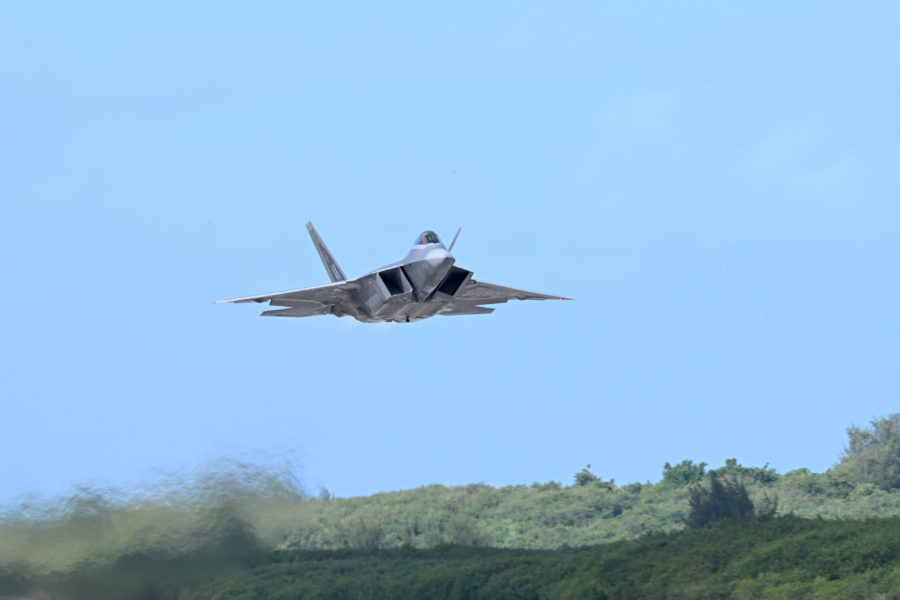For the first time, F-22s have deployed to the U.S. territory of Tinian, a small island around 100 miles north of the American military hub of Guam. The rotation of Raptors, which began March 1, is part of an exercise dubbed Agile Reaper 23-1.
Over time, the Department of Defense plans to turn Tinian into a permanent alternative location for aircraft operating out of Guam.
Over the first week of March, the Air Force will conduct flight operations from Tinian with F-22s from Joint Base Elmendorf-Richardson (JBER)’s 525th Expeditionary Fighter Squadron of 3rd Air Expedtionary Wing. The unit deployed to Kadena Air Base, Japan, in late 2022 to replace aging F-15 Eagle fighters.
“For them to come support this exercise shows how agile we truly are,” Col. Kevin “Jinx” Jamieson, the commander of the 3rd Air Expeditionary Wing, told Air & Space Forces Magazine in an email.
Wargames have shown U.S. air bases in Japan and Guam would likely be targets should the U.S. be drawn into a conflict with China. Service officials believe the U.S. needs more airfields in the Indo-Pacific to counter the threat of Chinese cruise and ballistic missiles and have introduced the concept of Agile Combat Employment, known as ACE, to meet the threat.
“Guam and the Northern Mariana Islands are a strategic location that requires agility to defend if we find ourselves in a contested and degraded environment,” Jamieson said, adding that the excercise will give his team “a sense of reality and to rehearse in an environment that will likely challenge us real world.”
Having Tinian temporarily host American aircraft is not new—the U.S. first began using the island to launch warplanes after seizing it in World War II. It is, however, novel ground for the F-22, America’s premier air-to-air fighter.
In February, Tinian, one of the three main Northern Mariana Islands, hosted Air Force F-35 Lighting II fighters as part of exercise Cope North. The F-22’s operations at Tinian International Airport, which has just a single runway, mark the second time in less than a month that American fifth-generation stealth fighters have deployed there.
Crews on Tianan turning around F-22s so that they can flew sorties in the area’s training area, the Mariana Islands Range Complex (MIRC), which Jamieson called “an operationally relevant environment.”
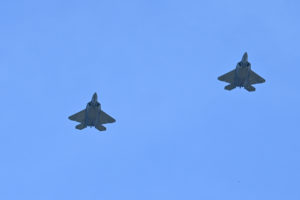
Two F-22 Raptors assigned to the 525th Expeditionary Fighter Squadron, Kadena Air Base, Japan, fly in formation during Exercise Agile Reaper over Tinian International Airport, Northern Mariana Islands, during Exercise Agile Reaper 23-1, March 2, 2023. Throughout the weeklong exercise, F-22 Raptors will fly sorties from locations within the Northern Mariana Islands in a first for the aircraft. AR 23-1 supports the Air Force’s requirement for expeditionary skills necessary to operate outside of military installations; Airmen must have diverse skills that enable them to operate in a contested, degraded, and operationally limited environment. (U.S. Air Force photo by Tech. Sgt. Hailey Staker)
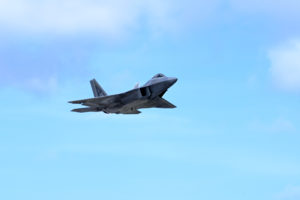
An F-22 Raptor assigned to the 525th Expeditionary Fighter Squadron, Kadena Air Base, Japan, launches from Tinian International Airport, Northern Mariana Islands, during Exercise Agile Reaper 23-1, March 2, 2023. Throughout the weeklong exercise, F-22 Raptors will fly sorties from locations within the Northern Mariana Islands in a first for the aircraft. AR 23-1 supports the Air Force’s requirement for expeditionary skills necessary to operate outside of military installations; Airmen must have diverse skills that enable them to operate in a contested, degraded, and operationally limited environment. (U.S. Air Force photo by Tech. Sgt. Hailey Staker)
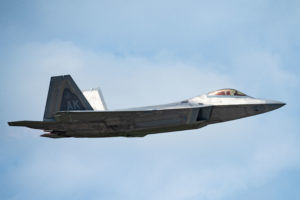
F-22 Raptors assigned to the 525th Expeditionary Fighter Squadron, Kadena Air Base, Japan, take off from Tinian International Airport, Northern Mariana Islands, during Exercise Agile Reaper 23-1, March 2, 2023. AR 23-1 presents an opportunity for Airmen from the 3rd Air Expeditionary Wing to practice and execute their ability to rapidly move personnel, materiel, equipment, and aircraft to, from, and within a theater. (U.S. Air Force photo by Airman 1st Class Julia Lebens)
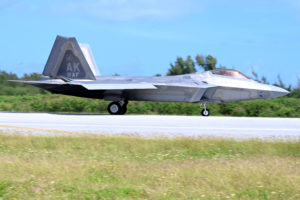
An F-22 Raptor assigned to the 525th Expeditionary Fighter Squadron, Kadena Air Base, Japan, lands at Tinian International Airport, Northern Mariana Islands, after conducting training in the Mariana Islands Range Training during Exercise Agile Reaper 23-1, March 2, 2023. During the exercise, C-17s assigned to the 517th Airlift Squadron and F-22 Raptors will conduct training operations in the Mariana Islands Range Training Complex. The MIRC is a geographic area containing a complex of military training ranges, and includes land, sea, and airspace on and around the islands of Guam, Rota, Tinian, Saipan, and Farallon de Medinilla, as well as open ocean waters stretching north to Pagan and west to the middle of the Philippine Sea. (U.S. Air Force photo by Tech. Sgt. Hailey Staker)
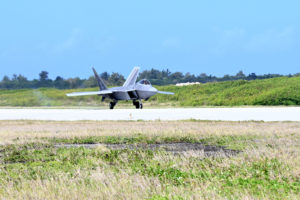
An F-22 Raptor assigned to the 525th Expeditionary Fighter Squadron, Kadena Air Base, Japan, lands at Tinian International Airport, Northern Mariana Islands, after conducting training in the Mariana Islands Range Training during Exercise Agile Reaper 23-1, March 2, 2023. During the exercise, C-17s assigned to the 517th Airlift Squadron and F-22 Raptors will conduct training operations in the Mariana Islands Range Training Complex. The MIRC is a geographic area containing a complex of military training ranges, and includes land, sea, and airspace on and around the islands of Guam, Rota, Tinian, Saipan, and Farallon de Medinilla, as well as open ocean waters stretching north to Pagan and west to the middle of the Philippine Sea. (U.S. Air Force photo by Tech. Sgt. Hailey Staker)
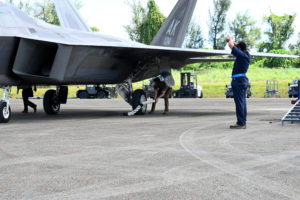
Crew chiefs assigned to the 525th Aircraft Maintenance Unit, Kadena Air Base, Japan, park and chalk an F-22 Raptor assigned to the 525th Expeditionary Fighter Squadron, Kadena AB, after landing at Tinian International Airport, Northern Mariana Islands, during Exercise Agile Reaper 23-1, March 2, 2023. AR 23-1 is an Agile Combat Employment exercise and tests ACE’s hub and spoke frameworks by only employing bare-necessity, mission essential personnel and equipment to operate in a degraded environment. (U.S. Air Force photo by Tech. Sgt. Hailey Staker)
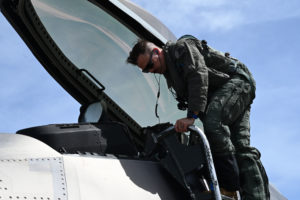
Fury, an F-22 Raptor pilot assigned to the 525th Aircraft Maintenance Unit, Kadena Air Base, Japan, climbs out of an F-22 Raptor at Tinian International Airport, Northern Mariana Islands, after conducting training in the Mariana Islands Range Training during Exercise Agile Reaper 23-1, March 2, 2023. During the exercise, C-17s assigned to the 517th Airlift Squadron and F-22 Raptors will conduct training operations in the Mariana Islands Range Training Complex. The MIRC is a geographic area containing a complex of military training ranges, and includes land, sea, and airspace on and around the islands of Guam, Rota, Tinian, Saipan, and Farallon de Medinilla, as well as open ocean waters stretching north to Pagan and west to the middle of the Philippine Sea. (U.S. Air Force photo by Tech. Sgt. Hailey Staker)
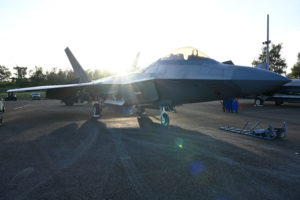
An F-22 Raptor assigned to the 525th Expeditionary Fighter Squadron, Kadena Air Base, Japan, sits on the flight line during pre-flight maintenance for Exercise Agile Reaper 23-1 at Tinian International Airport, Northern Mariana Islands, March 2, 2023. Throughout the weeklong exercise, F-22 Raptors will fly sorties from locations within the Northern Mariana Islands in a first for the aircraft. AR 23-1 supports the Air Force’s requirement for expeditionary skills necessary to operate outside of military installations; Airmen must have diverse skills that enable them to operate in a contested, degraded, and operationally limited environment. (U.S. Air Force photo by Tech. Sgt. Hailey Staker)
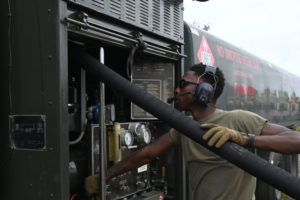
Airman 1st Class Arion White, a fuels distribution operator assigned to the 3rd Air Expeditionary Wing, reels in a fuel hose after refueling an F-22 Raptor assigned to the 525th Expeditionary Fighter Squadron, Kadena Air Base, Japan, during Exercise Agile Reaper 23-1 at Tinian International Airport, Northern Mariana Islands, March 1, 2023. AR 23-1 is an Agile Combat Employment exercise and tests ACE’s hub and spoke frameworks by only employing bare-necessity, mission essential personnel and equipment to operate in a degraded environment. (U.S. Air Force photo by Tech. Sgt. Hailey Staker)
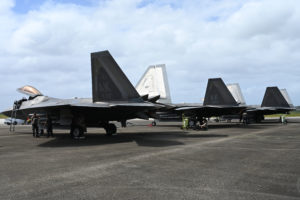
F-22 Raptors assigned to the 525th Expeditionary Fighter Squadron, Kadena Air Base, Japan, sit on the flight line after landing during Exercise Agile Reaper 23-1 at Tinian International Airport, Northern Mariana Islands, March 1, 2023. Throughout the weeklong exercise, F-22 Raptors will fly sorties from locations within the Northern Mariana Islands in a first for the aircraft. AR 23-1 supports the Air Force’s requirement for expeditionary skills necessary to operate outside of military installations; Airmen must have diverse skills that enable them to operate in a contested, degraded, and operationally limited environment. (U.S. Air Force photo by Tech. Sgt. Hailey Staker)
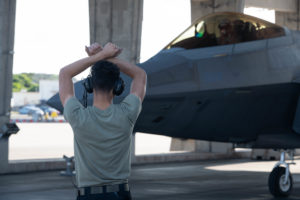
Airman 1st Class Khyrese Roberts, 525th Aircraft Maintenance Unit assistant dedicated crew chief, marshals an F-22A Raptor prior to departure at Kadena Air Base, Japan, March 1, 2023. Agile Reaper 23-1 is the 3rd Air Expeditionary Wing’s effort to exercise agile combat employment and allows personnel to rehearse capabilities to provide air dominance, global mobility and command and control for the U.S. Indo-Pacific Command commander. (U.S. Air Force photo by Airman 1st Class Tylir Meyer)
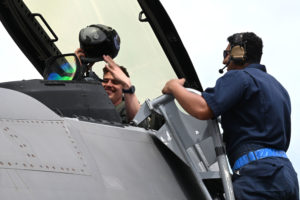
Rowdy, left, an F-22 Raptor pilot assigned to the 525th Expeditionary Fighter Squadron, Kadena Air Base, Japan, catches up with Senior Airman Alexander Blum-Ramos, right, a crew chief assigned to the 525th EFS, after landing during Exercise Agile Reaper 23-1 at Tinian International Airport, Northern Mariana Islands, March 1, 2023. Throughout the weeklong exercise, F-22 Raptors will fly sorties from locations within the Northern Mariana Islands in a first for the aircraft. AR 23-1 is an Agile Combat Employment exercise and tests ACE’s hub and spoke frameworks by only employing bare-necessity, mission essential personnel and equipment to operate in a degraded environment. (U.S. Air Force photo by Tech. Sgt. Hailey Staker)
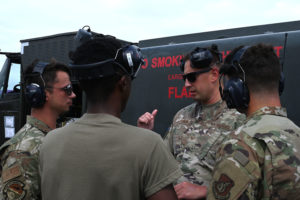
Tech. Sgt. Jordan Laughlin, the fuels distribution section chief assigned to the 3rd Air Expeditionary Wing, briefs his fuels distribution operators on refueling operations during Exercise Agile Reaper 23-1 at Tinian International Airport, Northern Mariana Islands, March 1, 2023. AR 23-1 supports the Air Force’s requirement for expeditionary skills necessary to operate outside of military installations; Airmen must have diverse skills that enable them to operate in a contested, degraded, and operationally limited environment. (U.S. Air Force photo by Tech. Sgt. Hailey Staker)
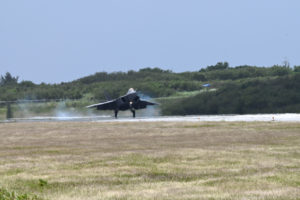
An F-22 Raptor assigned to the 525th Expeditionary Fighter Squadron, Kadena Air Base, Japan, lands during Exercise Agile Reaper 23-1 at Tinian International Airport, Northern Mariana Islands, March 1, 2023. During the exercise, C-17s and F-22 Raptors assigned to the 525th Expeditionary Fighter Squadron will conduct training operations in the Mariana Islands Range Training Complex. The MIRC is a geographic area containing a complex of military training ranges, and includes land, sea, and airspace on and around the islands of Guam, Rota, Tinian, Saipan, and Farallon de Medinilla, as well as open ocean waters stretching north to Pagan and west to the middle of the Philippine Sea. (U.S. Air Force photo by Tech. Sgt. Hailey Staker)
F-22s will operate with maintenance personnel and other ground crew in the Northern Mariana Islands but receive support from additional aircraft flying out of Guam, including KC-135 Stratotanker refuelers, C-17 cargo planes, and a E-3 Sentry AWACS aircraft.
“We are operating as a hub-and-spoke which is a major element within the ACE operational framework,” Jamieson said. “The hub is located at Andersen AFB here at Guam and the spoke is operating out of Tinian International Airport.”
JBER’s aircraft are part of Pacific Air Forces, but its F-22s deploy around the world, from the Middle East to Europe, and have now set up operations at Kadena on a rotational basis. Nevertheless, its Airmen still call Alaska home.
“From 10 degrees and snowing, to 90 and raining, Airmen from the 3rd AEW will use [Agile Reaper] 23-1 to practice and validate new ways to deploy, maneuver and project power,” JBER said in a March 1 news release.
In addition to the F-22s, the C-17s in the excercise are also from JBER as well Joint Base Pearl Harbor-Hickham, Hawaii. Guam is roughly 4,000 miles west of Hawaii and more than 4,500 miles from Alaska, but long-distance missions are commonplace for C-17s.
Though not part of the Agile Reaper exercise, operating from short and rough runways is one of the elements of the ACE and something the C-17 was designed to do. So to put the aircraft and Airmen out of their comfort zone, some C-17s participating in Agile Reaper have already conducted flight operations out of Anderson under minimal light with air traffic controllers wearing night vision goggles.
The Air Force says Agile Reaper is a prime test for “ACE’s hub and spoke frameworks by only employing bare-necessity, mission essential personnel and equipment to operate in a degraded environment.”
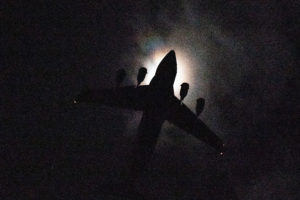
A C-17 Globemaster III assigned to the 15th Wing, Joint Base Pearl-Hickam, Hawaii, conducts training at a landing zone with minimal light at Andersen Air Force Base, Guam, during Exercise Agile Reaper 23-1, March 2, 2023. AR 23-1 supports the Air Force’s requirement for expeditionary skills necessary to operate outside of military installations; Airmen must have diverse skills that enable them to operate in a contested, degraded, and operationally limited environment. (U.S. Air Force photo by Airman 1st Class Julia Lebens) 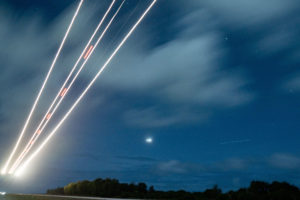
A C-17 Globemaster III assigned to the 15th Wing, Joint Base Pearl-Hickam, Hawaii, conducts training at a landing zone with minimal light at Andersen Air Force Base, Guam, during exercise Agile Reaper 23-1, March 2, 2023. AR 23-1 supports the Air Force’s requirement for expeditionary skills necessary to operate outside of military installations; Airmen must have diverse skills that enable them to operate in a contested, degraded, and operationally limited environment. (U.S. Air Force photo by Airman 1st Class Julia Lebens)
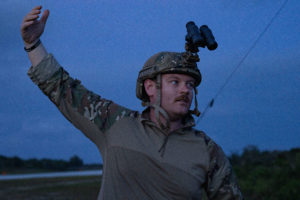
An air traffic controller assigned to the 3rd Air Expeditionary Wing prepares to conduct low light airfield training while wearing night vision at Andersen Air Force Base, Guam, during Exercise Agile Reaper 23-1, March 2, 2023. AR 23-1 is the 3rd Air Expeditionary Wing’s effort to exercise Agile Combat Employment and allows personnel to rehearse capabilities to provide air dominance, global mobility, and command/control for the U.S. Indo-Pacific Command commander. (U.S. Air Force photo by Airman 1st Class Julia Lebens)

A C-17 Globemaster III assigned to the 15th Wing, Joint Base Pearl-Hickam, Hawaii, conducts training at a landing zone with minimal light at Andersen Air Force Base, Guam, during Exercise Agile Reaper 23-1, March 2, 2023. AR 23-1 supports the Air Force’s requirement for expeditionary skills necessary to operate outside of military installations; Airmen must have diverse skills that enable them to operate in a contested, degraded, and operationally limited environment. (U.S. Air Force photo by Airman 1st Class Julia Lebens)
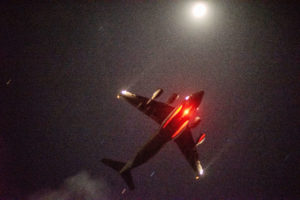
A C-17 Globemaster III assigned to the 15th Wing, Joint Base Pearl-Hickam, Hawaii, conducts training at a landing zone with minimal light at Andersen Air Force Base, Guam, during exercise Agile Reaper 23-1, March 2, 2023. AR 23-1 supports the Air Force’s requirement for expeditionary skills necessary to operate outside of military installations; Airmen must have diverse skills that enable them to operate in a contested, degraded, and operationally limited environment. (U.S. Air Force photo by Airman 1st Class Julia Lebens)

A C-17 Globemaster III assigned to the 15th Wing, Joint Base Pearl-Hickam, Hawaii, conducts training at a landing zone with minimal light at Andersen Air Force Base, Guam, during exercise Agile Reaper 23-1, March 2, 2023. AR 23-1 supports the Air Force’s requirement for expeditionary skills necessary to operate outside of military installations; Airmen must have diverse skills that enable them to operate in a contested, degraded, and operationally limited environment. (U.S. Air Force photo by Airman 1st Class Julia Lebens)
